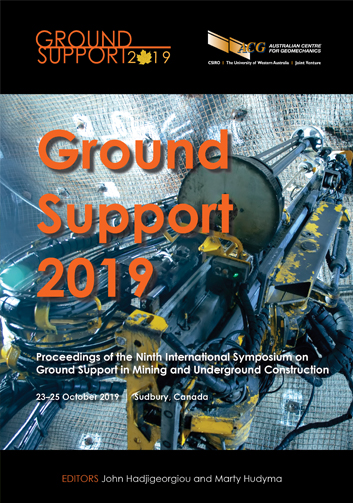Evaluation of ground support design at Eleonore Mine via Bonded Block Modelling

|
Authors: Garza-Cruz, T; Bouzeran, L; Pierce, M; Jalbout, A; Ruest, M |
DOI https://doi.org/10.36487/ACG_rep/1925_23_Garza-Cruz
Cite As:
Garza-Cruz, T, Bouzeran, L, Pierce, M, Jalbout, A & Ruest, M 2019, 'Evaluation of ground support design at Eleonore Mine via Bonded Block Modelling', in J Hadjigeorgiou & M Hudyma (eds), Ground Support 2019: Proceedings of the Ninth International Symposium on Ground Support in Mining and Underground Construction, Australian Centre for Geomechanics, Perth, pp. 341-356, https://doi.org/10.36487/ACG_rep/1925_23_Garza-Cruz
Abstract:
The ability to understand and predict the effectiveness and evolving capacity of ground support in mine accesses is paramount to the success of an operation. This paper describes the results of numerical modelling studies of ground support performance in access drifts at Eleonore Mine. These drifts are located in competent rock with undulating sub-horizontal and vertical jointing present and are subjected to mining-induced stress. The studies employ Bonded Block Models (BBM) with explicit ground support represented by the newly developed hybrid bolts in 3DEC (Itasca Consulting Group, Inc. 2016a). These models are used to back-analyse and understand past falls of ground as well as to evaluate the adequacy of the current designs to handle future conditions as mining advances. The shallow dip and undulation of the sub-horizontal joints strongly impact the back behaviour in accesses, with joints susceptible to shearing and opening under high horizontal stresses. The results of the study elucidated that the falls of ground experienced at the mine are due to the bolts in the back (#6 rebar) being heavily strained locally through sub-horizontal joint shearing as nearby stoping took place, causing them to rupture. As foreseen by the mine in 2016, the model results confirm the need for bolts with higher shearing capacity to support the on-ore drifts. Both D-bolts and #7 rebar were analysed as alternatives with the model and shown to provide superior deformation compatibility, which agrees with experience on the mine. D-bolts offer a less stiff response (which increases survivability under highly localised deformations), while #7 rebar offers a higher yield strength. This paper describes how numerical models that allow for realistic fracturing and bulking of the rock mass along with explicit representation of pre-existing discontinuities can be used to more realistically model ground support performance in competent rock.
Keywords: ground support, Bonded Block Model, BBM, stoping
© Copyright 2025, Australian Centre for Geomechanics (ACG), The University of Western Australia. All rights reserved.
View copyright/legal information
Please direct any queries or error reports to repository-acg@uwa.edu.au
View copyright/legal information
Please direct any queries or error reports to repository-acg@uwa.edu.au